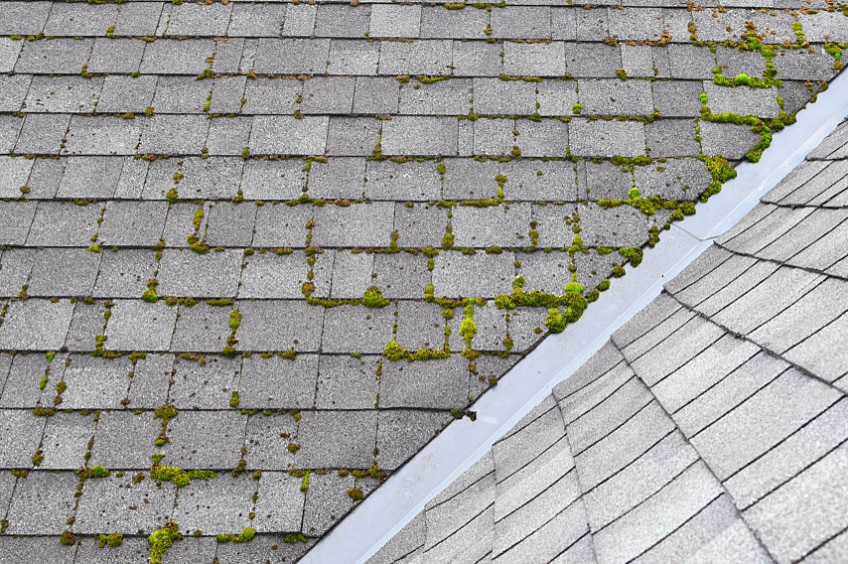While moss can sometimes give a roof an appealingly aged, old-world look, unfortunately it can also have a severe impact on its durability if left untreated. If you notice any of these tiny, fast-growing plants taking up residence on top of your home, it's best to start the roof moss removal process sooner rather than later. The longer it's left, the harder it is to remove—and the greater the damage to your roof.
One thing to know is that moss doesn't necessarily just stay on your roof's surface: it's also happy to begin spreading its tendrils beneath the shingles. And since moss collects moisture, it will expand and then lift your shingles, creating openings for water to get through. Moss also causes shingle deterioration by removing the granules that protect the roof against ultraviolet rays. Read on to learn more about roof moss, the steps to take to get it removed by a professional, and how to prevent it from happening in the first place.
Why Moss Grows on Roofs and How to Prevent It
Shade and excessive moisture are the key factors that can encourage moss to build up on your roof. Getting rid of these two conditions and having systems in place to avoid them in future can help prevent moss from popping up.
Shade
Moss plants prefer to grow in the shade, so removing any obviously shady areas is a useful first preventative step. This might mean trimming tree branches that extend over your roof, for instance. Trimming branches can also reduce the chance of damage to your shingles if branches snap and fall during a storm.
Drainage
Ensure your roof has a working drainage system to avoid water buildup. Routinely clean your gutters and downspouts to remove any leaves or debris that might prevent rainwater from properly draining away.
How Moss Can Damage Your Roof
Moss can damage your roof in several ways, some of which can cause additional problems inside your home.
Since moss absorbs water, rainwater is absorbed by the moss instead of just draining away or drying off. This retained water can degrade shingles over time, causing them to lose protective granules that protect your home against UV rays.
The excess moisture can also make its way to the roofing materials below the shingles, causing wood and other structural rot inside your home. Mold growth in the roof and attic can also occur due to moisture retained by moss.
In addition, moss can attract pests such as insects and birds. If the moss has also created openings beneath the shingles, this could lead to a serious pest infestation that would be expensive to remove.
How to Remove Moss from Your Roof
Removing moss from your roof can help you avoid these potentially significant forms of damage, so it's important to look out for any spots you find growing there and deal with them sooner rather than later.
1. Call a Roofing Professional
Rather than getting up on the roof yourself, it's a smart idea to contact a professional, who can ensure the moss is removed safely.
2. Moss Remover Spray Solution
Your contractor will most likely use a spray solution to kill off the moss, which makes it easier to remove. Note that many roof moss removal solutions can also damage other plants. In case the solution drips off your roof, it's a good idea to cover up any plant life that might be underneath to keep it safe and to make the contractor aware of garden areas where they should be extra-careful.
3. Rinsing the Solution
After letting the solution soak for the appropriate time, your contractor can rinse all the treated areas with water, using a hose. They should apply the water at a low pressure toward the moss, ensuring the water only targets the moss and shingles at a downward angle. Spraying pressurized water at an upward angle can cause shingles to lift and possibly warp.
4. Removing the Moss
It will now be much easier to have the moss removed from your shingles. From the safety of a secured ladder, a professional can remove as much moss as they can from the shingles. Another method is to use a reaching stick to clear some areas without needing to climb on the roof. Whichever method is used, a roofing professional will know best how to proceed to ensure your roof is adequately cleaned.
Maintenance
While you might be tempted to use a pressure washer yourself to clean the roof yourself, resist this urge. A pressure washer releases water too powerfully, which can cause your roof shingles to lose their granules and lift. The best way to keep your roof moss-free is to make sure it is routinely inspected for this or any other potential infestation or problem—minor or major. Professional roof inspections are an important part of maintaining your roof so it will have a longer lifespan and save you money on expensive repairs or replacement down the road. Contact a roofing professional certified by GAF* in your area for your next inspection!
*Contractors enrolled in GAF certification programs are not employees or agents of GAF, and GAF does not control or otherwise supervise these independent businesses. Contractors may receive benefits, such as loyalty rewards points and discounts on marketing tools from GAF for participating in the program and offering GAF enhanced warranties, which require the use of a minimum amount of GAF products.

